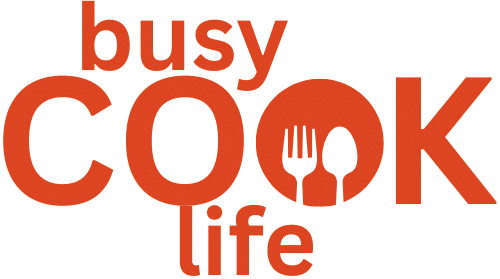Hi — I’m Emma, 37, from Asheville. Sticky summer afternoons. A toddler decorating the floor with cereal. I needed a quick calm boost. So here’s how I do it…
I call it my weekday hero. This iced matcha latte recipe cools me down fast. It gives gentle energy. And yes — it tastes café-fancy without the price. Bright green powder whisked with hot (not boiling) water, poured over ice, then topped with milk. Simple. Fast. Cozy.
I love that matcha is kinder than coffee for afternoons — about ~70 mg caffeine versus roughly 100–140 mg in coffee. Use a bamboo whisk, a frother, or a blender to avoid clumps. Small ice cubes melt slower, so the drink stays bold.
Want the full how-to and tiny tweaks? Check my go-to link for a clear step-by-step and extras like lavender or vanilla-maple in a quick post at my favorite iced matcha latte guide. If you can whisk and pour, you can make this at home — five minutes, one bowl, and done before the next “Mom?”
Key Takeaways
- Quick, five-minute drink that feels special.
- Sift and whisk powder with hot water to avoid lumps.
- Smaller ice cubes dilute less; use milk of choice.
- Matcha gives a gentler lift than coffee.
- Tools like a bamboo whisk or frother make it smooth.
Why I keep coming back to this iced matcha latte recipe on busy, sticky summer afternoons
Afternoon heat, a humming fan, and me trying to steal a minute — that’s when this drink shows up. I reach for something bright and fast. I want calm focus, not a jittery crash.
A quick love letter from my Asheville kitchen:
A quick love letter to my green ritual
I love the grassy, creamy swirl. It tastes like a tiny reset I can sip while I tidy blocks and answer a “why?”
When coffee is too much, but nap time is too short
Coffee hits me hard after lunch. Matcha gives a steadier lift. I can finish dinner and still sleep.
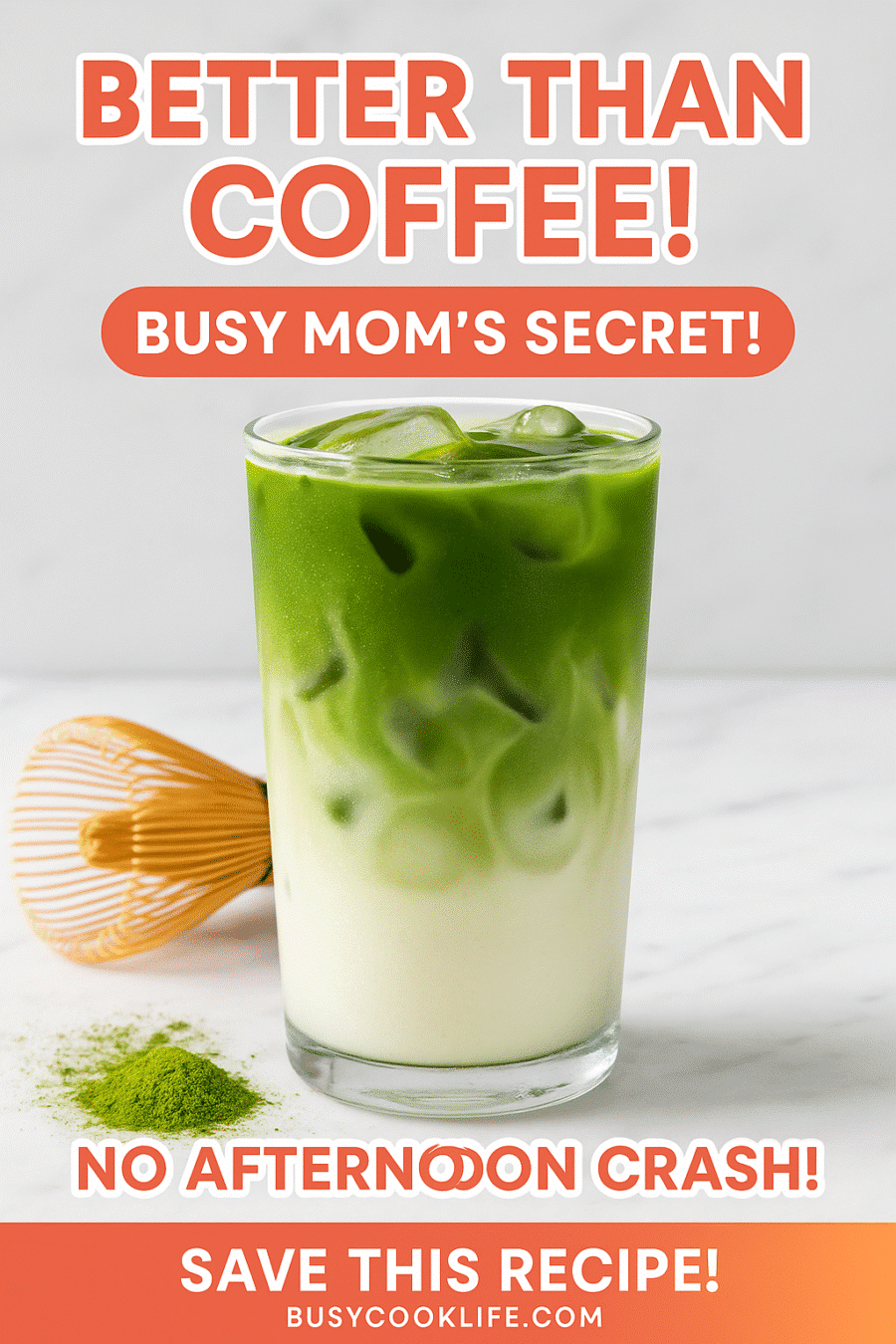
- Tiny ritual: quick whisk, clink of ice, splash of milk — five minutes.
- Flexible: unsweetened or a touch of maple; both feel light and fresh.
- Quality matters: bright, shade-grown powder for sipping; dull powder stays for baking.
- Budget win: making it at home tastes luxe without the café price.
“It’s my five-minute pause in the chaos.”
Next, I’ll share simple tips so you skip bitterness and avoid clumps. You don’t have to give up coffee — this is just the perfect afternoon pick-me-up at home.
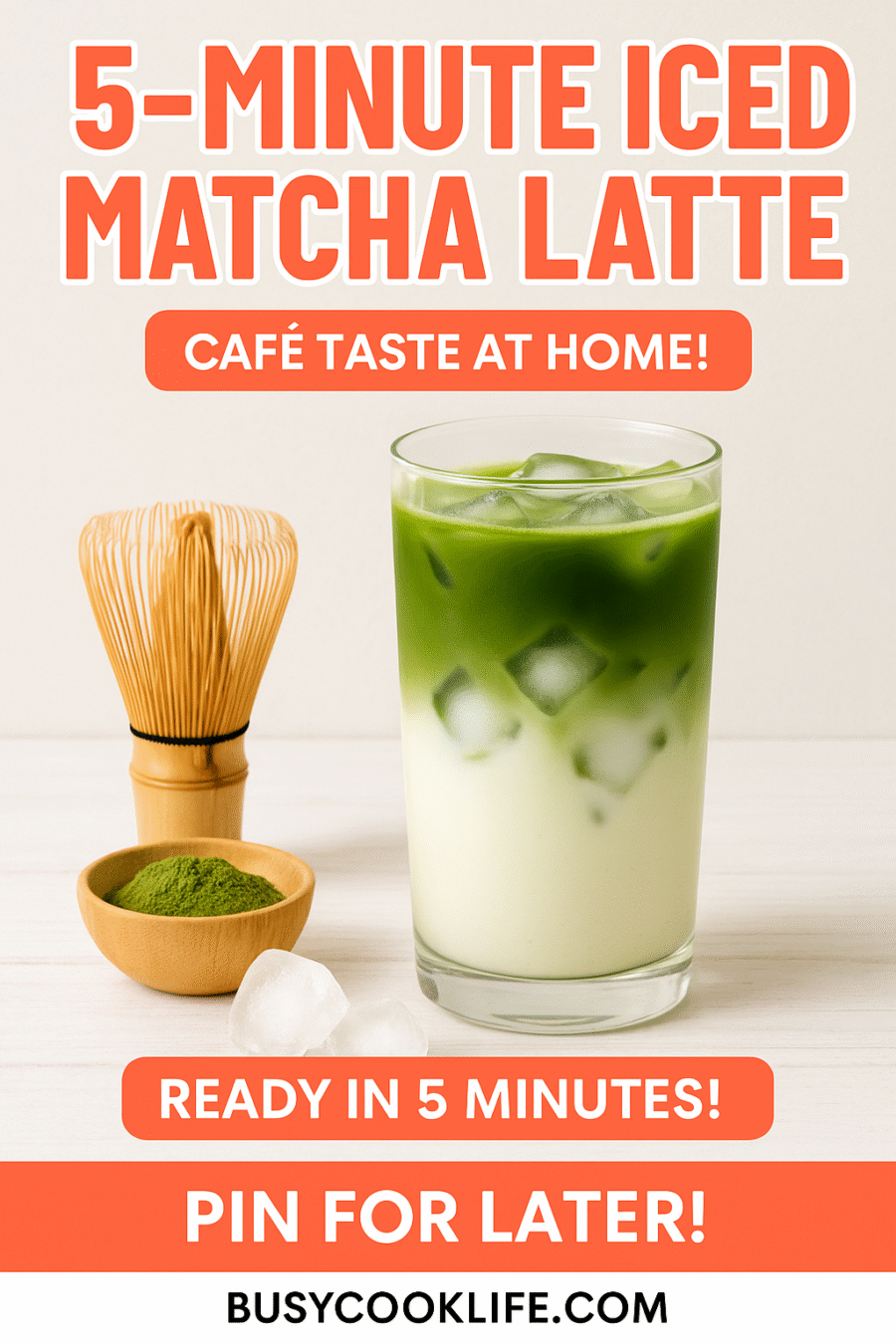
iced matcha latte recipe
When I need a quick chill, I make this in five minutes flat. So here’s how I do it…
Simple steps I use every time
Sift a teaspoon of matcha powder into a small bowl. Sifting breaks up sneaky clumps and saves time.
- Add about 1/4 cup hot water—recently boiled then cooled—and whisk in quick zigzags until smooth and a bit frothy.
- Fill a tall glass with ice all the way. This keeps the drink cold and the color bright.
- Carefully pour matcha into the glass, then top with about 1 cup milk of your choice.
- Add a touch of sweetener if you want—maple blends in fast. Give it one quick stir and taste.
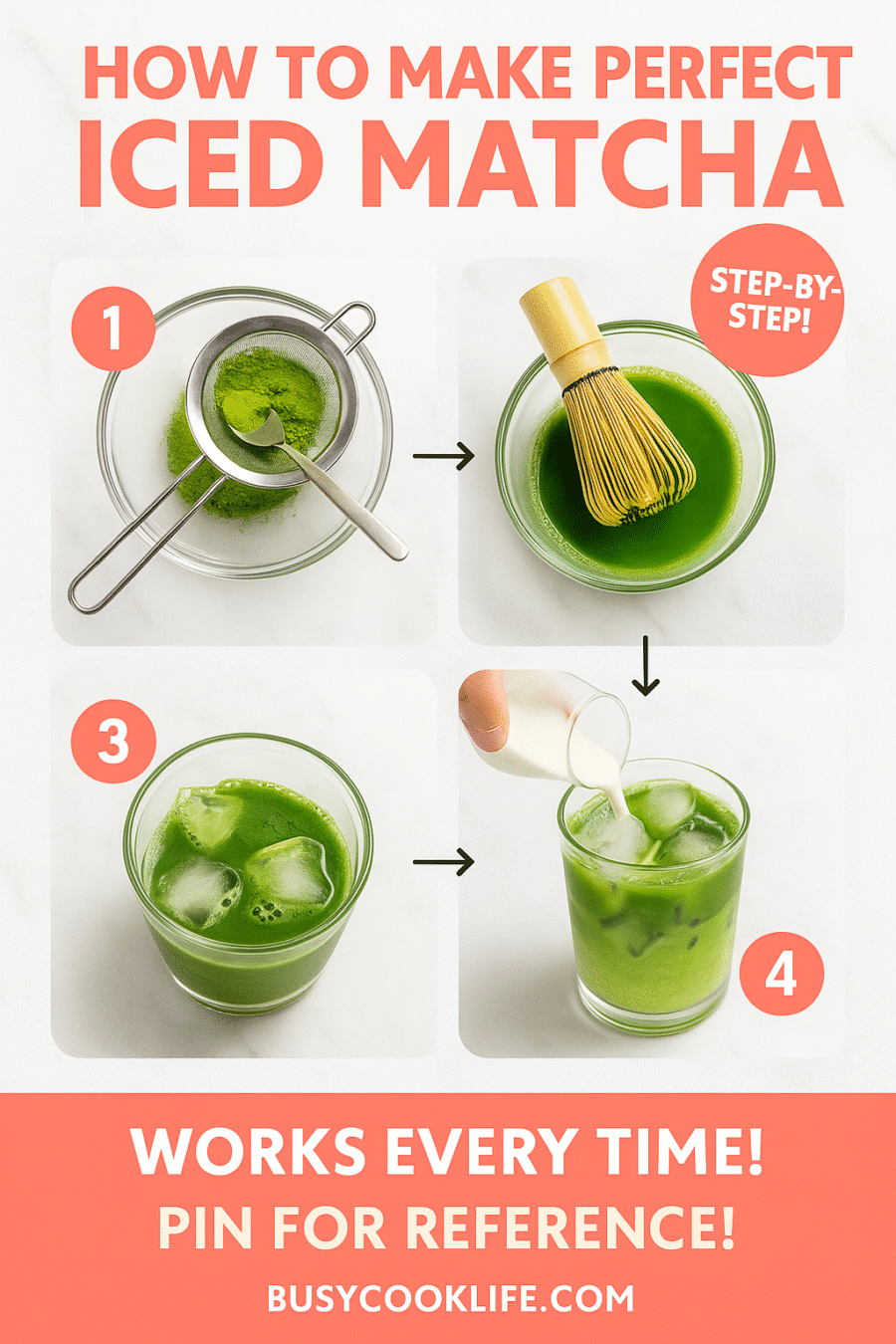
- If lumps sneak in, blitz the powder and hot water in a blender next time. Works like a charm.
Ratio tip: I keep it simple—roughly 1 teaspoon to 8 ounces total. Adjust stronger if you need a bigger lift. Try this matcha latte and enjoy a café-level glass at home.
What matcha is—and why shade-grown tea leaves make all the difference
Shade makes all the difference — and that’s where matcha begins. It starts as green tea grown under cloth or bamboo canopies. The plants get extra shade for weeks before harvest. That boosts chlorophyll and gives the leaves a bright, grassy flavor.
After picking, the leaves get steamed to stop oxidation. Then they dry and are stone-ground into a fine powder. You drink the whole leaf, not a steeped bag. That’s why the flavor feels fuller and the color pops.
Ceremonial vs. culinary: which grade to use?
Ceremonial grade tastes smooth and less bitter. I reach for it when I want a vibrant cup or a creamy matcha latte. It whips well and looks neon-green with milk.
Culinary grade runs stronger and a bit bitter. I save it for baking, smoothies, or bold blends. If you’re new, buy a small tin of ceremonial grade so you can see the difference.
- Pick powders with one ingredient: green tea.
- Quality matters more than color fixes or extra sweetener.
“A teaspoon of better powder beats a cup of sugar every time.”
Ingredients & tools I actually use at home
I keep my countertop lineup simple so I can make a good cup fast.
Core ingredients: matcha powder, water, cold milk, and plenty of ice. I measure things in a single cup and a small bowl so cleanup stays quick.
Matcha powder, water, milk, ice, and the right whisk
I whisk the powder with just-boiled but rested water. That wakes the flavor without burning it.
I prefer small ice cubes—they chill faster and dilute less. For milk, oat makes it creamy, soy feels classic, almond stays light, and whole milk gives a richer finish.
Bamboo whisk, handheld frother, or blender: which one works best
- Bamboo whisk: dreamy froth and tradition. Quick zigzags break lumps and make tiny bubbles.
- Handheld frother: fast on busy mornings. Power through clumps, rinse, done.
- Blender: my toddler-proof choice. Hot water and powder blitz into a lump-free base in seconds.
My pantry sweeteners: maple syrup, simple syrup, or sugar
I keep maple syrup on the counter for a warm, caramel note. Simple syrup is my go-to when I want even sweetness. Granulated sugar or coconut sugar work if I stir longer.
“Everything fits in a cup and a bowl—fewer dishes, more sipping.”
| Item | Why I use it | Best for | Notes |
|---|---|---|---|
| Matcha powder | Bright flavor, whole-leaf boost | Sipping or creamy cups | Sift before whisking |
| Bamboo whisk | Silky froth, classic feel | Delicate foam | Dry and store upright |
| Handheld frother / Blender | Speed and lump-free texture | Busy mornings, kids helping | Rinse immediately after use |
| Maple syrup / Simple syrup | Fast dissolving sweeteners | Balanced sweetness | Keep small jar on counter |
Step-by-step: whisk, pour, swirl, sip
I like quick, clear steps—so here’s how I make it every single time. This part takes about a few minutes and gets you a smooth, bright cup fast.
Sift or whisk out clumps in a small bowl
I sift the powder into a small bowl first. That stops sneaky clumps. Less fuss, better texture.
Use hot—not boiling—water to wake up the matcha
Add a splash of hot water—just off the boil. Then whisk fast. Keep going until it looks glossy and lump-free. About 20 to 30 seconds does it.
Pour over a tall glass of ice, then add cold milk
Pack a tall glass with ice so the drink stays cold. Pour matcha slowly and watch the bright ribbon slip between the cubes. Top with cold milk and let the colors swirl for a beat.
Sweeten to taste and give it a quick stir
Add your sweetener—a teaspoon of maple works for me. Give one quick stir and sip. If it’s strong, add a splash more milk. If it’s weak, whisk a little extra next time.
“Five minutes from whisk to sip—easy cleanup, big moment of calm.”
Pro tips for a smooth, vibrant latte every time
A few fast habits stop bitterness and save you time.
Water first: Use just-off-the-boil water. Boiling water can scorch powder and turn green tea bitter. Let the kettle sit 30–45 seconds before you pour.
Whisk like you mean it: Move in quick M or W motions. That builds micro-foam and removes lumps fast. A bamboo whisk gives the nicest, softest bubbles. If you use a frother, pulse briefly.
Sift before you whisk. It keeps sandy clumps out of your bowl. You’ll spend less time fixing texture later.
Small ice cubes and why they matter
Use small cubes. They chill quickly and melt slower in layers. That keeps the drink bold, not watery.
If the color looks dull, check two things: your grade and your water temperature first. Ceremonial grade usually gives a brighter, smoother sip.
- Aim for a thin, glossy base before you add milk — even color, no streaks.
- Keep your ratio steady and tweak slowly until it fits your taste.
- Clean tools right away — leftover residue tastes bitter next time.
“Simple habits keep each cup bright, smooth, and full of calm.”
| Tip | Why it helps | Quick action |
|---|---|---|
| Just-off-the-boil water | Prevents scorching and bitterness | Let kettle rest 30–45 seconds |
| Vigorous whisking | Removes lumps and builds foam | Use M/W motion for 20–30 seconds |
| Small ice cubes | Chill faster; dilute less | Use tray with small molds |
| Ceremonial grade powder | Brighter color, smoother taste | Buy small tin to test |
Milk and sweetener combos that never miss
A simple swap of milk or sweetener can flip the whole vibe of a glass. I pick combos by mood—cozy, clean, or light—and taste what each one does.
Dairy and non-dairy options
Oat milk gives the creamiest body and a soft, gentle sweetness that flatters green tea powder. It’s my go-to when I want comfort.
Soy milk feels classic and steady. It foams well and leaves a clean finish—great when I want the powder to sing.
Almond milk keeps things lighter. Expect a faint nutty note and a crisp sip.
Whole milk goes plush. It makes a rich, dessert-like cup that feels indulgent.
How sweeteners change flavor and feel
Maple syrup adds caramel-vanilla hints and melts right into cold drinks. I use it when I want warmth.
Simple syrup gives pure sweetness without shifting flavor—reliable for clear, iced versions.
Coconut sugar tastes toasty but needs stirring. Agave disappears fast and tastes neutral. Unsweetened works too—just use a brighter powder and spot-on water temp.
- My go-to pairs: oat + maple for cozy, soy + simple syrup for clean, almond with no sweetener for light and bright.
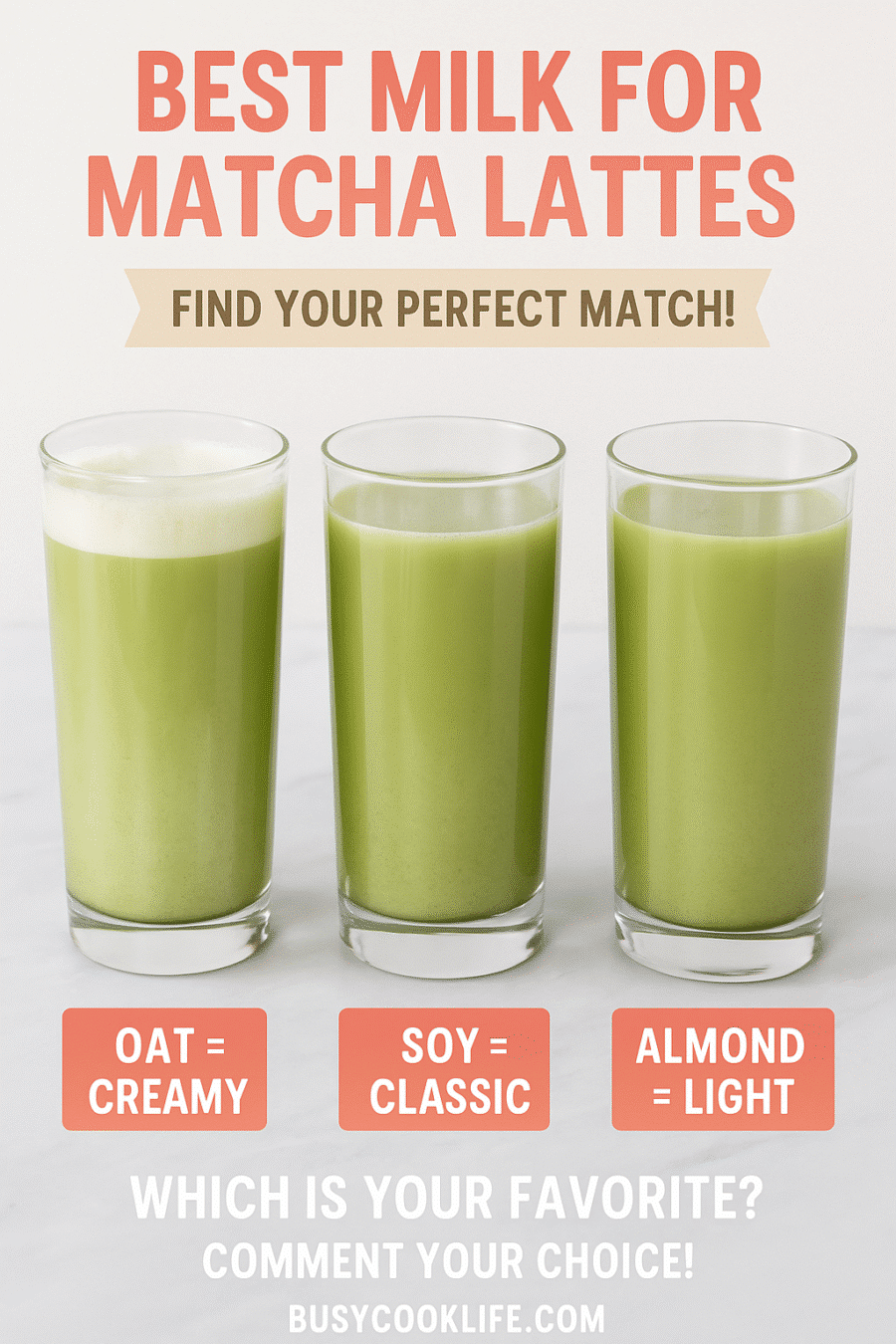
- Swap one thing and the whole drink changes.
Want playful variations? See a list of matcha latte variations and ideas here.
Easy flavor twists when you’re feeling playful
I love turning one simple base into a handful of fun sips. These three quick spins take minutes and brighten an ordinary afternoon.
Strawberry
Blend about 1/3 cup fresh strawberries with 1 teaspoon sugar until smooth.
Chill the puree so it won’t melt the ice. Add it to a glass with ice, pour your milk, then float the whisked matcha on top for a pretty ombré.
Lavender
Whisk your powder with hot water, then stir in 1 tablespoon lavender syrup.
Pour over ice and top with milk. Stir gently so the floral note stays gentle, not overpowering. Soy pairs well here for a clean finish.
Vanilla-maple
Add a splash of vanilla extract and a drizzle of maple syrup to your whisked base.
Top with milk and taste. It’s cozy and café-like, with no fuss.
- Keep ratios steady so flavor doesn’t drown the green base—start small and taste.
- Chill fruit purees first to protect the ice and layers.
- Oat milk pairs best with strawberry and vanilla; soy suits lavender.
- Garnish with a strawberry slice or a tiny lavender sprinkle for a quick finish.
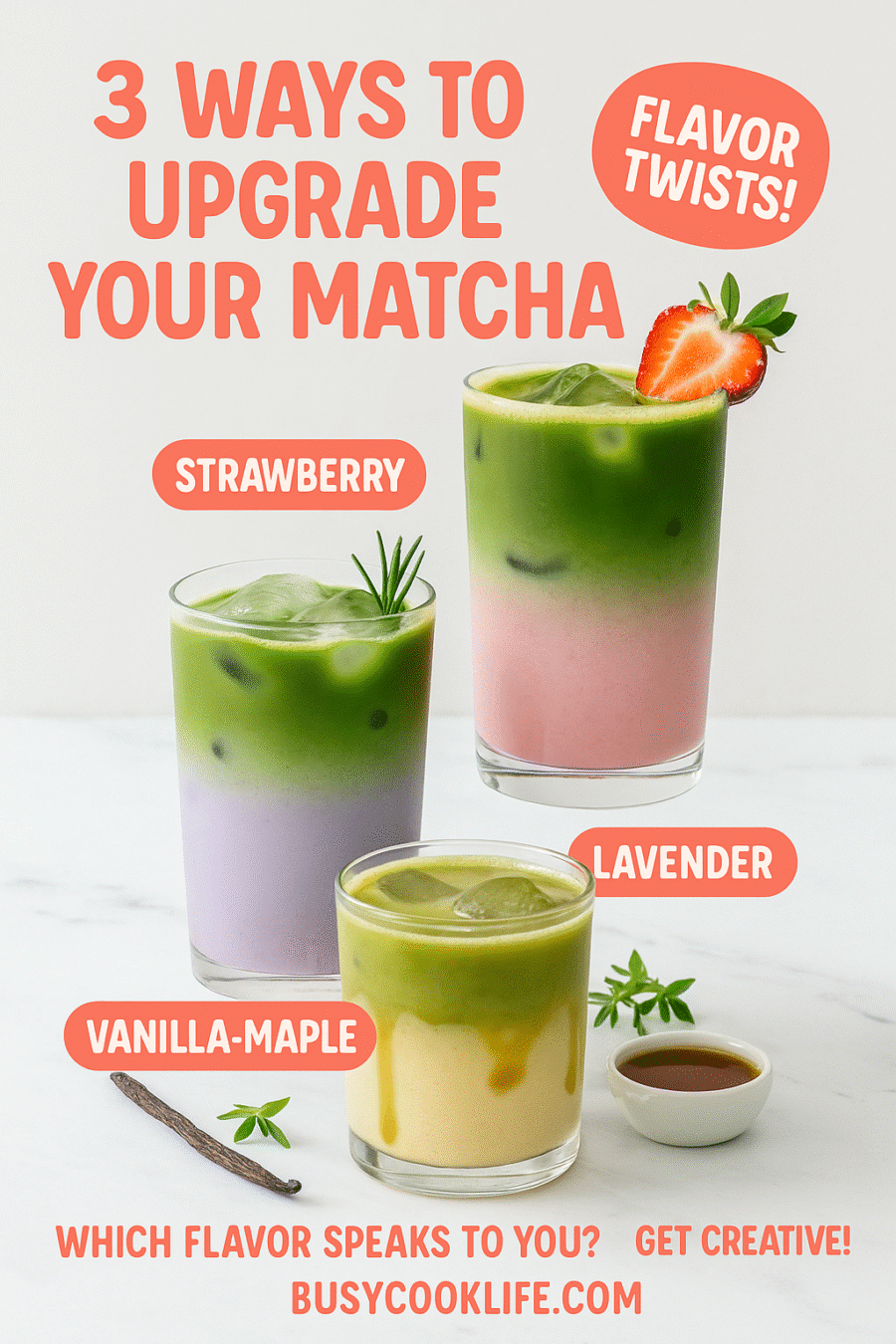
“One base, three moods—easy tweaks that take minutes and feel special.”
Matcha grades, color, and taste: picking a good one
Color tells you a lot before you even sniff the tin. I hold the tin in natural light and look for a bright, spring-green hue. That usually means smoother flavor and a sweeter finish in the cup.
Ceremonial grade powders show that neon pop. They taste round and less bitter. Culinary or dull olive tones often read bitter, especially with cold milk.
- Look for bright, spring-green powder—it usually tastes smoother and sweeter in the cup.
- Dull or olive tones often read bitter, especially with cold milk.
- Ceremonial grade usually gives you that neon pop and a balanced, nutty finish.
- I check color in natural light before I buy or brew.
I store mine tightly sealed and away from heat. If your drink looks muddy, try a fresher tin or a different brand. A tiny test helps: whisk 1/2 teaspoon with hot water and sip — good powder tastes clean, never astringent.
With the right grade, you’ll need less sweetener and still get a smooth sip.
Want a quick primer on matcha basics? See my short guide matcha basics before you buy.
Blender and frother shortcuts when the toddler is “helping”
When little hands appear, I reach for the fastest trick in my kitchen. It keeps the chaos calm and the cup smooth.
Blending with hot water for lump-free magic
Quick method: toss your powder and just-off-the-boil hot water into the blender. Five seconds of high speed and it goes silky and bright—no sifting, no stress.
I pour that base over ice, add milk, and sweeten right in the glass. Fewer dishes and a happy helper. If I need two drinks, the blender scales in minutes and stays consistent.
- I run the blender base under cold water for a second to ease steam and keep seals happy.
- Frother hack: tilt the cup and keep the head under the surface to stop splashes.
- For travel mugs, blend first, then fill with ice and milk and I’m out the door.
- Even budget powder goes smooth—this shortcut saves time at home and keeps texture even.
“Five seconds in the blender and you’ve got a creamy, lump-free cup—kids helped, mess minimal.”
Make-ahead and storage notes that actually work
I like to have a chilled concentrate ready so I can move fast. It saves minutes on hectic mornings and keeps the cup bright.
What to whisk ahead, what to pour last
I whisk a simple concentrate—powder plus water—and chill it in a jar. That base keeps for up to a day in the fridge. Shake before you pour so the color and texture return.
I add milk and ice only when I serve. That prevents separation and dilution. If you want sweet already mixed, make a small batch of simple syrup. It blends instantly into cold drinks.
- I pre-pack glasses with ice in the morning. Then I pour and stir when I’m ready.
- I mark the jar with a cup count so I know how many lattes remain.
- If separation appears, a quick shake fixes it in seconds.
- I never store milk in the concentrate—flavor fades and the texture thins overnight.
“Make once, sip twice—that’s my weekday treat plan.”
| Prep Step | Why it helps | How long it keeps |
|---|---|---|
| Whisked concentrate (powder + water) | Fast pour-in base; smooth texture after shaking | Up to 24 hours in fridge |
| Simple syrup ready | Instantly sweetens cold drinks | 2 weeks in sealed jar |
| Pre-packed cup with ice | Saves time; keeps color and body | Use within same morning |
Caffeine, calm focus, and how matcha stacks up to coffee
When I need steady focus, I reach for a calmer green drink. It gives a soft lift without the afternoon crash I used to get from larger doses of coffee.
Gentle energy: average caffeine in matcha vs. coffee
Numbers help: a serving of matcha runs about ~70 mg of caffeine. A typical cup of coffee can hit 100–140 mg.
What I notice: the energy from matcha feels steady. It lasts through school pickup and dinner prep. I get fewer jitters and less of a crash.
- I reach for matcha when I want calm focus and steady energy.
- On average, a cup of matcha lands around ~70 mg caffeine; coffee can run 100–140 mg.
- I feel fewer jitters and less of a crash with matcha in the afternoon.
- If you’re sensitive, start with 1/2 teaspoon and see how you feel.
- For early mornings, I might still choose coffee; for later, matcha wins.
“This swap kept my evenings calmer and my bedtime easier.”
| Drink | Avg. caffeine | Feel | Best time |
|---|---|---|---|
| Matcha (1 tsp) | ~70 mg | Steady, sustained | Afternoons, gentle focus |
| Coffee (8 oz) | 100–140 mg | Strong, quicker spike | Early mornings |
| Green tea (bag) | 20–45 mg | Light, subtle | Low-caffeine moments |
Cost and time: café taste without the café price
Saving money never tasted so good. I make a café-level glass in a few easy steps. It takes about 5 minutes. So, I skip the drive and sip sooner.
Five-minute routine, everyday ingredients
Quick and low-fuss—this is what works for me. I keep the ingredient list tiny. Matcha, water, milk, ice, and a touch of sweetener if I want it. That’s it.
- I make this in five minutes flat—faster than buckling into the car.
- The list stays short: matcha, water, milk, ice, and maybe a sweetener.
- One small tin stretches into many cups, so the price per glass drops fast.
- I use what I already have at home; no special grocery trips required.
- Cleanup is a quick rinse and a bowl in the sink—no fuss.
- It’s easier to tweak sweetness and strength at home than at the café counter.
- If you love daily cold drinks, this swap saves real money in a week.
- I batch a whisked base for two days when I know it’ll be hot outside.
- The taste feels café-level because the method is the same—whisk, pour, swirl.
- It fits into nap windows, work breaks, and that five-minute pocket before errands.
“Fast, cheap, and cozy—the little ritual that pays for itself.”
Serving ideas and little snacks that play nice
Serve this one with simple snacks and a clear glass so the color can sing.
I put it in a tall, clear glass. The bright green shows up and looks fun on the table.
Salt balances the creamy milk and grassy notes. I grab crackers or roasted nuts. They snap the richness and keep the sip fresh.
Fresh fruit pairs well. Strawberries and peaches echo the green and add a sweet pop.
For cozy snack o’clock, I heat my Microwave Chocolate Mug Cake from BusyCookLife.com and sip between bites. It’s fast and home-friendly.
If I want something lighter, I grab yogurt with granola. I take a bite, then a cool sip.
I toss in extra ice just before serving so the drink stays cold to the last sip. A metal straw keeps it frosty for longer.
“Simple, pretty, and fast — that’s the whole point here.”
Quick tips: dust a pinch of powder for café flair. Keep napkins handy for toddler cheers. Use a jar lid for travel.
| Snack | Why it works | Best pairing | Serve idea |
|---|---|---|---|
| Crackers or roasted nuts | Salty crunch balances cream | Any neutral milk | Small bowl beside a clear glass |
| Fresh strawberries or peaches | Bright, fruity contrast | Oat or almond milk | Sliced on a small plate |
| Microwave Chocolate Mug Cake | Cozy sweet for snack o’clock | Whole milk for indulgence | Warm mug plus chilled glass |
| Yogurt with granola | Light, crunchy, and quick | Any milk; no sweetener needed | Spoon between sips |
More cozy sips to try next
Some evenings I crave comfort that takes two minutes, not an hour. I keep a few microwave tricks ready so I can have a warm cup fast and still tuck the kiddo in on time.
Craving warm and quick? Check my microwave mug lineup on BusyCookLife.com for straight-to-the-point ideas you can make at home.
Quick, cozy mugs I reach for
- Microwave Chai Latte Mug — a quick spice hug after dinner.
- Microwave Cinnamon Roll Mug — silly, soft, and surprisingly perfect with a small matcha on the side.
- Microwave Hot Cocoa Mug — two minutes to chocolate comfort for movie nights.
If you like this method, you’ll love how fast those cups come together. Same cozy style, same simple pantry ingredients, all ready in minutes.
“Quick sips are a busy cook’s best friend, promise.”
Bookmark a few so your next craving has a plan. These small wins make evenings feel a touch calmer and more intentional at home.
Troubleshooting: fix clumps, bitterness, or a too-milky sip
A few tiny tweaks save a sad cup and get you back to a smooth, bright sip. Below I list quick problems and clear fixes. Try one change at a time so you can taste the difference.
Clumpy powder: sift, whisk, or blend
Clumps? Sift the powder first. Then whisk with hot water until glossy and lump-free.
If that still leaves bits, blend the base for five seconds. It solves stubborn clumps fast.
Too bitter: grade, temp, and sweetener
Too bitter? Use just-off-the-boil water — boiling water scorches the leaf. Try ceremonial grade if harshness remains.
Add a tiny touch of sweetener to soften edges without hiding the green flavor.
Tastes like milk: tweak the ratio
Too milky? Increase matcha by 1/4 teaspoon or cut back the milk a splash. A common ratio is about 1 tsp to 8 oz total.
If your lattes separate, give the glass a quick stir before you sip. And if the cup looks dull, check freshness and storage—air and heat fade it.
- Gritty texture? Whisk faster and shorter; build micro-foam.
- Make one change at a time. That helps you learn what matters most.
Conclusion
One quick whisk and you’ve got a bright glass that feels like a tiny reset.
This simple routine—sift, whisk, pour, swirl—gives you a creamy, vivid cup in minutes. You get gentle energy without leaning on coffee late in the day.
With good powder and the right water temp, your matcha latte stays smooth and bold. Use oat + maple for cozy, soy + simple for clean, or try strawberry for fun.
Adjust the ratio, keep the ice small, and you’ll nail your perfect sip fast. I keep a chilled base ready so my afternoon treat takes almost no time.
Now grab your whisk and make iced matcha — you deserve a cool, calm moment today.
— Emma

FAQ
What kind of powder should I use for the best flavor?
I use ceremonial-grade green tea powder when I want a bright, grassy cup. For everyday lattes, culinary grade works fine — it’s more budget-friendly and mixes well with milk. Look for vibrant color and a fresh smell.
How do I avoid clumps when I whisk the powder?
I sift the powder into a small bowl first, then add a splash of hot water (not boiling) and briskly whisk with a bamboo whisk or handheld frother. If I’m rushed I blend it for 10–15 seconds — lump-free every time.
What’s the right water temperature to wake up the tea without bitterness?
Heat water to about 175°F (just under boiling). Too hot and the leaf tastes bitter. Too cool and it won’t bloom. I eyeball it by letting boiling water sit for a minute before pouring.
Which milk choice makes the creamiest cup?
Oat milk is my go-to for creaminess and a neutral flavor, but whole milk gives the richest result. Almond and soy work too — pick what you like and what’s in your pantry.
How much sweetener should I add, and what’s best?
Start with a teaspoon of maple syrup or a tablespoon of simple syrup for one serving. I like maple for cozy notes, simple syrup for even sweetness, and sugar if you’re stirring hot. Adjust to taste.
Can I make a batch ahead of time?
Yes — whisk the powder with hot water, then cool and store the concentrate in the fridge up to 48 hours. Pour over ice and add milk just before serving so it stays bright and fresh.
How much caffeine is in one serving compared to coffee?
A typical serving has moderate caffeine — less than a drip coffee but enough for steady focus. It feels gentler, thanks to L-theanine in the leaf that smooths the buzz.
Any quick fixes if the drink tastes bitter or too vegetal?
Try a sweeter touch (maple or simple syrup), lower the water temp, or use a higher-grade powder. Also check your matcha-to-liquid ratio — too much powder can overwhelm the milk.
What ice tips make the drink less diluted?
Use small, dense ice cubes or chilled milk so the drink chills fast and stays flavorful longer. I sometimes freeze milk into cubes when I’m planning ahead.
Can I use a blender or frother instead of a whisk?
Absolutely. A handheld frother works great for single cups, and a blender makes smooth drinks fast when the toddler’s “helping.” Both beat clumps and give nice foam.
Any fun flavor twists that don’t take long?
Yes — a splash of vanilla and maple for cozy vibes, a few muddled strawberries for a fruity spin, or a lavender syrup for floral notes. Small additions go a long way.
How do I store leftover powder and how long does it last?
Keep the powder in an airtight container, away from light and heat. Stored well, it stays good for months — but fresher is brighter, so use it up within a few months for best color and taste.
Can kids drink this, and should I worry about caffeine?
It’s milder than coffee, but it still has caffeine. I limit servings for kids and try a smaller portion with more milk. If you’re concerned, dilute it more or skip the powder for a warm milk treat.
How long does it take to make from start to finish?
About five minutes if you’ve got everything ready — sift, whisk, pour over ice, add milk, sweeten, and stir. It’s a quick, everyday pick-me-up.
Any gear I should splurge on for better results?
A good bamboo whisk and a fine sifter make a big difference. A handheld frother is a cheap time-saver. If you love smoothies, a small blender is worth it too.
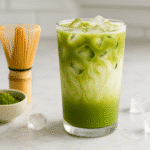
My Favorite Iced Matcha Latte Recipe – Refreshing & Easy!
- Prep Time: 5
- Total Time: 5
- Yield: 1 1x
- Category: Beverages
- Method: No-Cook
- Cuisine: Japanese-Inspired
- Diet: Vegetarian
Description
This 5-minute iced matcha latte recipe creates a creamy, café-style drink at home using ceremonial-grade matcha powder. Perfect afternoon energy boost with gentle caffeine that’s kinder than coffee. No crash, just sustained focus and delicious flavor.
Ingredients
1 teaspoon ceremonial-grade matcha powder (sifted)
1/4 cup hot water (just off the boil, about 175°F)
Ice cubes (small cubes preferred for slower melting)
1 cup milk of choice (oat, soy, almond, or whole milk)
1–2 teaspoons sweetener (maple syrup, simple syrup, or sugar – optional)
Instructions
1. Sift the matcha powder into a small bowl to break up any clumps and ensure smooth texture
2. Add the hot (not boiling) water to the bowl and whisk vigorously in quick M or W motions for 20-30 seconds until smooth and frothy
3. Fill a tall glass completely with ice cubes, preferably small ones for slower dilution
4. Slowly pour the whisked matcha mixture over the ice, creating beautiful layers
5. Top with your choice of cold milk, pouring gently to maintain the layered effect
6. Add sweetener if desired and give one quick stir to blend flavors
7. Taste and adjust milk or matcha strength as needed for your perfect cup
8. Serve immediately and enjoy your café-quality iced matcha latte at home
Notes
For best results, use ceremonial-grade matcha for smoothness and vibrant green color. Culinary grade works for budget-friendly options but may taste slightly more bitter.
Water temperature is crucial – let boiling water rest 30-45 seconds before using to prevent scorching the delicate matcha leaves.
Small ice cubes melt slower and dilute the drink less than large cubes, keeping your latte bold and flavorful.
For a completely lump-free shortcut, blend the matcha and hot water for 5 seconds instead of whisking by hand.
Store leftover whisked matcha concentrate in the refrigerator for up to 24 hours – just shake well before using.
Milk choice affects texture: oat milk creates the creamiest body, soy milk gives classic café results, almond milk keeps it light and refreshing.
This recipe contains approximately 70mg of caffeine, compared to 100-140mg in a typical cup of coffee.
Nutrition
- Serving Size: 1
- Calories: 120
- Sugar: 8
- Sodium: 95
- Fat: 4
- Saturated Fat: 0.5
- Unsaturated Fat: 3
- Trans Fat: 0
- Carbohydrates: 18
- Fiber: 1
- Protein: 3
- Cholesterol: 0
